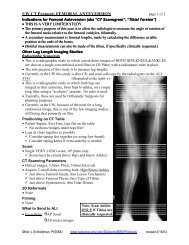Ankle and Foot 47 - Department of Radiology - University of ...
Ankle and Foot 47 - Department of Radiology - University of ...
Ankle and Foot 47 - Department of Radiology - University of ...
Create successful ePaper yourself
Turn your PDF publications into a flip-book with our unique Google optimized e-Paper software.
<strong>47</strong> <strong>Ankle</strong> <strong>and</strong> <strong>Foot</strong> 2249 <strong>47</strong><br />
Figure <strong>47</strong>-54. Peroneus brevis<br />
tear in a 62-year-old. This is a sideby-side<br />
comparison <strong>of</strong> the same<br />
straight axial slice acquired using<br />
T1-weighted (A), proton-density<br />
(PD)–weighted (B), <strong>and</strong> T2-<br />
weighted (C) images. Although T1<br />
shows the fat best <strong>and</strong> T2 shows<br />
the fluid best, PD shows the<br />
tendons best, particularly the<br />
abnormally increased signal in the<br />
split/abnormally flattened<br />
peroneus brevis tendon (white<br />
arrowhead).<br />
A<br />
B<br />
C<br />
A<br />
B<br />
Figure <strong>47</strong>-55. Comparison <strong>of</strong> T2 weighting with<br />
fat suppression (A) <strong>and</strong> T1 weighting with fat<br />
suppression after intravenous gadolinium (B) in a 65-<br />
year-old with rheumatoid arthritis. The bright T2<br />
signal in A in the posterior tibial (white arrow) <strong>and</strong><br />
flexor digitorum longus (white arrowhead) tendon<br />
sheaths is shown to be enhancing pannus in B. In<br />
comparison, the bright T2 signal in A adjacent to the<br />
extensor digitorum longus (black arrow) <strong>and</strong> the<br />
anterolateral ankle joint (black arrowhead) is shown to<br />
be nonenhancing fluid surrounded by a thin rim <strong>of</strong><br />
enhancing synovium in B.<br />
We sometimes use IVGd when we detect a s<strong>of</strong>t tissue<br />
mass that is bright on T2-weighted sequences <strong>and</strong> we wish<br />
to confirm whether it is solid (Fig. <strong>47</strong>-56) or cystic (Fig.<br />
<strong>47</strong>-57). IVGd is also useful for the detection <strong>of</strong> Morton’s<br />
neuroma by MRI (Fig. <strong>47</strong>-58). At UW, we prefer to image<br />
Morton’s neuroma with ultrasonography rather than<br />
MRI. 36<br />
The contrast-enhanced tissue can be made all the more<br />
conspicuous on T1-weighted images by suppressing the<br />
signal from fat, <strong>and</strong> we use fat suppression on nearly all <strong>of</strong><br />
our postcontrast images. When there is a concern that the<br />
degree <strong>of</strong> fat suppression may not be uniform throughout<br />
the image, fat-suppressed T1-weighted images can be<br />
obtained before the administration <strong>of</strong> IVGd to be compared<br />
side-by-side with the postcontrast fat-suppressed T1-<br />
weighted images.<br />
<strong>Ankle</strong> <strong>and</strong> <strong>Foot</strong> Injuries<br />
• <strong>Ankle</strong> Mortise Fractures<br />
• Malleoli/Syndesmosis 12<br />
Fractures <strong>of</strong> the medial <strong>and</strong> lateral malleoli are commonly<br />
the result <strong>of</strong> twisting injury <strong>of</strong> the talus in ankle mortise.<br />
Radiographs are usually sufficient for the management <strong>of</strong><br />
what are typically simple fractures. CT axial images through<br />
Ch0<strong>47</strong>-A05375.indd 2249<br />
9/9/2008 5:34:35 PM
















